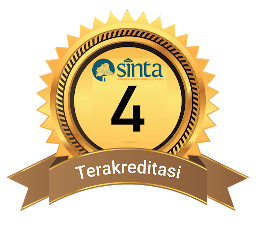Keterampilan Berpikir Kritis Siswa MAN Surabaya Materi Faktor Laju Reaksi dengan Inkuiri Terbimbing Online
DOI:
10.29303/cep.v4i1.2272Published:
2021-05-29Issue:
Vol. 4 No. 1 (2021): Edisi MeiArticles
Downloads
Additional Files
How to Cite
Abstract
Penelitian ini bertujuan untuk mengetahui keterlaksanaan model pembelajaran inkuiri terbimbing, aktivitas siswa, keterampilan berpikir kritis, hasil belajar ranah kognitif, dan respon siswa melalui penerapan model pembelajaran inkuiri terbimbing pada submateri faktor-faktor yang memengaruhi laju reaksi. Metode penelitian ini menggunakan One Group Pretest-Posttest Design dengan sampel penelitian yaitu 30siswa kelas XI MIPA5 MANSurabaya. Data yang diperoleh dianalisis menggunakan metode analisis kuantitatif. Penelitian ini menunjukkan hasil sebagai berikut: (1) Keterlaksanaan model pembelajaran inkuiri terbimbing pada pertemuan 1mendapatkan pesrsentase sebesar 92,45% , pada pertemuan 2 sebesar 94,8% dengan kategori sangat baik. (2) Aktivitas siswaselama proses pembelajaran yang memperoleh persentase lebih besar adalah aktivitas yang relevan dibandingkan aktivitas yang tidak relevan. (3) Peningkatan keterampilan berpikir kritis berdasarkan hasil N-Gain sebesar 93,65% siswa mendapatkan N-Gain dengan kriteria tinggi dan sebesar 0,04% mendapatkan N-Gain dengan kriteria sedang (4) Hasil belajar ranah kognitif siswa kelas XI MIPA 5 di MAN SURABAYA memperoleh nilai ââ°Â¥ 75 dinyatakan tuntas dengan nilai rata-rata sebesar 86 dan ketuntasan klasikal sebesar 100% (5) Respon siswa terhadap model pembelajaran yang diterapkan yaitu inkuiri terbimbing sangat baik dengan persentase sebesar 98,3%.References
Al-Aluf, W. dan S. (2018). Pengembangan LKS Berorientasi Inkuiri Terbimbing Untuk Melatihkan Berpikir Kritis Peserta Didik Pada Materi Asam Basa Kelas XI SMA Negeri 2 Bangkalan. Unesa Journal of Chemical, 7, No 2.
Almuntasheri, S., Gillies, R. M., & Wright, T. (2016). The Effectiveness of a Guided Inquiry-based, Teachersââ¬â¢ Professional Development Programme on Saudi Studentsââ¬â¢ Understanding of Density. Journal Science Education International, 27(1), 16-39, 16ââ¬â39.
Basuki, B. B dan Novita, D. (2019). Implementasi Model belajar mengajar Guided Inquiry dengan Pendekatan Nested supaya Melatih Keterampilan Berpikir Kritis Siswa Kelas XI Sekolah Menengah Atas pada Materi Laju Reaksi. UNESA Journal of Chemical Education, Vol. 8, No. 2, Pp. 250-258.
Dahar, R. W. (2011). Teori Belajar dan Belajar mengajar. Erlangga.
Depdikbud. (2013). Peraturan Mendikbud No.69 Th. 2013 MEngenai Kerangka Dasar dan Struktur Kurikulum SMA/MA. Departemen Pendidikan dan Budaya.
Depdiknas. (2006). Peraturan Mendiknas No 22 Th. 2006 Mengenai Standar Isi. Depdiknas.
Facione, P. A. (2011). Critical Thinking: What it is and Why it Counts. Insight Assesment.
Hake, R. . (1998). Interactive-engagement Versus Traditional Method: A six-Thousand-Students Survey of Mechanic Test Data For Introductory Physic Course. Am. Journal. Phys. Vol. 66, Hlm. 66-74., hlm. 66-74.
Kemendikbud. (2014). Peraturan Mendikbud No. 59 Th. 2014 Mengenai Kurikulum 2013 SMA/MA. Kemendikbud.
Permendikbud. (2016). Peraturan Mendikbud No. 21 Th. 2016 Mengenai Standar Isi dikdasmen. Peraturan Mendikbud.
Purba, M. (2006). Kimia untuk Sekolah Menengah Atas Kelas XI IPA. Erlangga.
Rahmadhani, P., Novita, D., dan Yonata, B. (2017). Implementations of Guided Inquiry Learning Model With Nested Method to Increase Critical Thinking Skill for Eleven-Grade Student at SMAN 1 Manyar Gresik in Reaction Rate Matter. UNESA Journal of Chemical Education, Vol. 7, No. 1, Pp. 39-45.
Ridwan. (2015). Skala dalam mengukur Variabel-variabel Penelitian. Alfabeta.
Sugiyono. (2015). Metode Penelitian Kuantitatif, Kualitatif, dan R&D. Alfabeta.
Sumintono, B., Ibrahim, M., dan Phang, F. (2010). Pembelajaran Sains melalui Praktikum Laboratorium: Perspektif dari Guru Sains SMP Negeri di Kota Cimahi. Jurnal Pengajaran MIPA, 15 (2).
Author Biographies
Ervina Fadhilatul Ishma, Universitas Negeri Surabaya
Dian Novita, Universitas Negeri Surabaya
License
Authors who publish with Chemistry Education Practice agree to the following terms:
- Authors retain copyright and grant the journal right of first publication with the work simultaneously licensed under a Creative Commons Attribution License 4.0 International License (CC-BY-SA License). This license allows authors to use all articles, data sets, graphics, and appendices in data mining applications, search engines, web sites, blogs, and other platforms by providing an appropriate reference. The journal allows the author(s) to hold the copyright without restrictions and will retain publishing rights without restrictions.
- Authors are able to enter into separate, additional contractual arrangements for the non-exclusive distribution of the journal's published version of the work (e.g., post it to an institutional repository or publish it in a book), with an acknowledgement of its initial publication in Chemistry Education Practice.
- Authors are permitted and encouraged to post their work online (e.g., in institutional repositories or on their website) prior to and during the submission process, as it can lead to productive exchanges, as well as earlier and greater citation of published work (See The Effect of Open Access).






